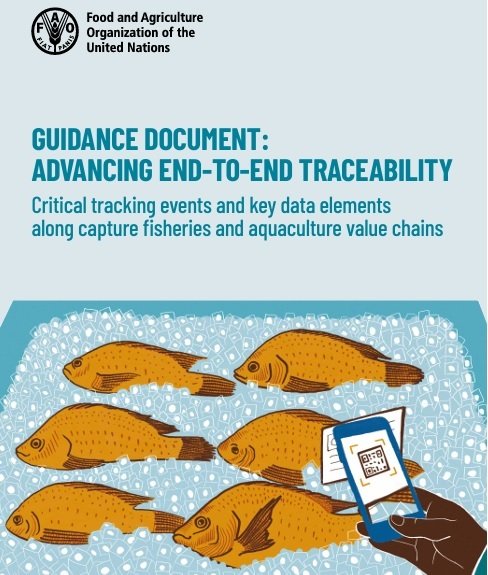
The ‘Guidance document: Advancing end-to-end traceability along capture fisheries and aquaculture value chains’ addresses a critical need for consensus in establishing ‘end-to-end’ traceability through a globally standardized and agreed understanding of critical tracking events (CTEs) along the fish value chain, as well as key data elements (KDEs) related to fish production and product identification.
The document aims to build knowledge and address gaps in the development and implementation of traceability systems for both the private sector and governments.
The guide also provides technical advice on the proper implementation and verification of traceability in fish value chains and seeks to serve as a benchmark for existing traceability systems to assess their effectiveness and identify associated gaps.
In this regard, the guidance document will help equip stakeholders with technical capabilities to support inclusive, transparent, efficient, and sustainable aquatic food systems, thereby enabling more efficient market access for fish and aquaculture products.
Fish Traceability
Traceability and its key role in terms of market access for both food safety and legal origin underpin international trade. According to ISO 9000:2015 standard, traceability of any product refers to ‘the ability to trace the history, application, or location of an object.’
According to the guidance document, in the product sense, traceability can be related to the origin of materials and parts, the processing history of the product, and the distribution and location of the product after delivery.
The provided definition of traceability clearly establishes what should be traced (history, application, and location) and what events should be traced. There are several principles or requirements that must be followed for an effective traceability system.
For the system to be effective, it is essential that codes of a Traceable Resource Unit (TRU), such as a raw material or a semi-finished product, entering a supply chain link, are uniquely associated with those of the same item.
CTEs and KDEs
The guidance document describes the processes of identifying CTEs and KDEs in fish and aquaculture value chains. In this regard, the following definitions, as established in the guide, are presented:
- CTE: Critical tracking event point at which the product moves between facilities or undergoes transformation, or is determined to be a point where data capture is necessary to maintain traceability.
- KDE: Key data element entry necessary to successfully trace a product and/or its ingredients through all relevant CTEs.
“By collecting and analyzing CTEs and KDEs from the regulatory domain and incorporating applicable ones from the regulatory domain, this document aims to facilitate the development of traceability systems that extend throughout the entire value chain,” the authors reported.
They also state that if many of the same CTEs and KDEs could be adopted at a level for seafood supply chains, “many traceability-related challenges such as inconsistent data formats and interoperability issues would be reduced, and resources of businesses and governments could be redirected towards verifying information in systems and other improvements”.
Critical Tracking Event Points and Key Data Element Entry in Aquaculture
The increasing complexity of value chains in aquaculture is the result of many requirements within the regulatory domain of traceability related to food safety, such as ownership-related requirements, permits for the use of production areas, license records, and environmental and labor conditions that are becoming market access issues in aquaculture production.
In general terms, traceability requirements for aquaculture have been driven by market access conditions for those intending to export their products.
The document describes the identification of CTEs and KDEs in food production and distribution, seed production (hatcheries, nurseries, etc.), fattening farms, collectors, distributors, traders, aggregators, and processing.
Recommendations
“As demonstrated by this document, establishing a consistent and widely adopted set of KDEs and CTEs is an essential part of functional and integrated traceability systems,” conclude the authors.
The general recommendations for countries are:
- Identify and define standardized KDEs and CTEs for commercial and regulatory traceability purposes, and
- Follow strict due diligence (using a holistic and integrated approach) involving all stakeholders at the legal, commercial, and operational levels before engagement.
The development of the guide was coordinated by the Value Chain Development Team of the FAO Fisheries and Aquaculture Division as part of the FAO Strategic Framework (Better Production, Better Nutrition, Better Environment, and Better Life) and the goal: Improved value chains ensure the social, economic, and environmental viability of aquatic food systems in the Blue Transformation Roadmap.
Reference (open access)
Blaha, F., Vincent, A. & Piedrahita, Y. 2023. Guidance document: Advancing end-to-end traceability – Critical tracking events and key data elements along capture fisheries and aquaculture value chains. Rome, FAO. https://doi.org/10.4060/cc5484en
Editor at the digital magazine AquaHoy. He holds a degree in Aquaculture Biology from the National University of Santa (UNS) and a Master’s degree in Science and Innovation Management from the Polytechnic University of Valencia, with postgraduate diplomas in Business Innovation and Innovation Management. He possesses extensive experience in the aquaculture and fisheries sector, having led the Fisheries Innovation Unit of the National Program for Innovation in Fisheries and Aquaculture (PNIPA). He has served as a senior consultant in technology watch, an innovation project formulator and advisor, and a lecturer at UNS. He is a member of the Peruvian College of Biologists and was recognized by the World Aquaculture Society (WAS) in 2016 for his contribution to aquaculture.
